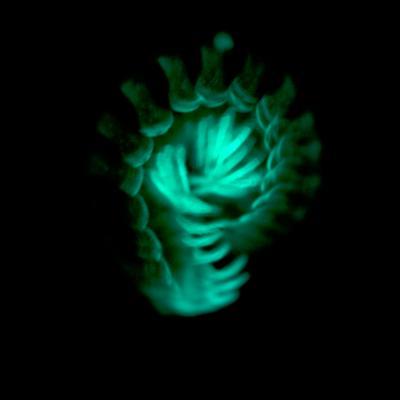Please note: Osher Rainforest will be closed for maintenance Jan. 14–16.
Science News
Glowing Millipedes
September 27, 2011

California is known for its amazing flora and fauna… and insects. Did you know we are home to glow-in-the-dark millipedes?
“There are only three places on the planet where you can see glow-in-the-dark millipedes,” according to University of Arizona’s Paul Marek. “The Santa Monica Mountains, the Tehachapi Mountains and the southern Sierra Nevada Mountains, all of which are in California.”
Marek should know—his interest in millipedes started prior to 1999 when he came to the Academy as an intern in the Summer Systematics Institute to work with curator and chair of entomology, Dave Kavanaugh.
These glow-in-the-dark variety of millipedes, all from the genus Motyxia, long remained a mystery to scientists. While bioluminescence is not unusual in the natural world, it is a bit for these creatures.
In some of the most common examples of glowing animals—including fireflies, glowworms and angler fish— bioluminescence may help attract mates, send messages back and forth among members of the same species, or even attract prey. But these millipedes are blind, so the reason for their glowing efforts had to be something else.
Marek and his colleagues hypothesized that the millipedes glow to avoid predation. Like animals with bright colors, the bioluminescence warns predators that these insects are toxic. “And they are,” says Ed Yong in his Discover blog.
…the millipedes create cyanide in their bodies and secrete the poison through pores along their flanks. They make for an unpleasant and possibly lethal mouthful.
So Marek and his team went about proving this hypothesis in a very meticulous way. They made 300 fake millipedes from clay and painted half with an artificial, long-lasting glow-in-the-dark paint.
They also collected live millipedes from a site in Giant Sequoia National Monument and divided them into two groups: one group was covered with paint to conceal their natural glow, the other was left untreated.
The team then set the live and clay millipedes out in the wild on a dark night, their natural environment. “If you sit there in a moonless night, the ground will look like the starry night sky up above, from all those millipedes glowing in the dark,” Marek explains.
To ensure the live millipedes wouldn’t escape, the researchers used a fly-fishing knot gently tied around their back segments to tether them to the ground.
The next morning, “It was just—carnage,” says Marek. “We were really surprised at the predation rate on these millipedes. Overall, about one-third of them—both real and fake—had been attacked.”
And just as Marek had suspected, four times as many non-glowing millipedes showed evidence of attacks compared to their glowing peers. Similarly, in the clay group, non-luminescent models were attacked twice as often as their glowing counterparts.
The study didn’t end there. To learn more about what kinds of predators had nibbled on—or devoured—the study subjects, Marek brought the clay models and the remains of the real millipedes to the rodent collection here at the Academy and matched the strike marks with the teeth in rodent skulls. Combining those data with observations at the study site, the team concluded that the grasshopper mouse (Onychomys torridus) is one of the millipedes’ most likely predators.
Talk about a thorough study! “It’s very cool that Paul came back to work here at the Academy in the mammal collection to try to match bite marks on his clay models to tooth patterns in skulls in our mammal collection to try to determine just what species were feeding on his millipedes,” says Marek’s former advisor Dave Kavanaugh. “I'm also excited to learn that we have the world's only glowing millipedes right here in California. I'd never seen them alive and glowing until Paul came here earlier this year and showed live ones glowing after his talk on this research. I also like his ingenious tests of predation using clay models. He always was innovative and novel!”
What’s next for Paul Marek and the glowing millipedes? Unlocking the precise biochemical mechanism by which the millipedes achieve bioluminescence.
“For now, all that we know is they use a different mechanism than fireflies or glowworms, which use an enzymatic reaction. The millipedes have a photoprotein that is similar to the Green Fluorescent Protein of the jellyfish Aequorea victoria. It is thought to be activated by calcium and energy-rich compounds in the cell to create the glow.”
We can’t wait to hear how he solves this mystery!
Image: Paul Marek